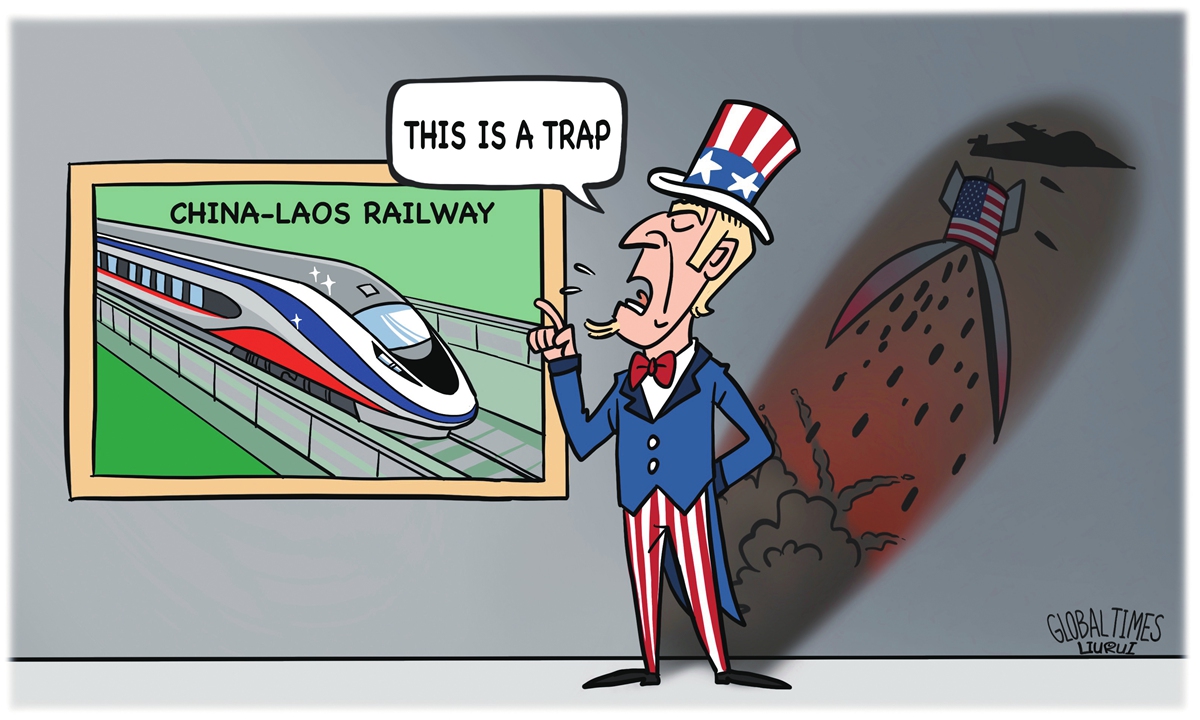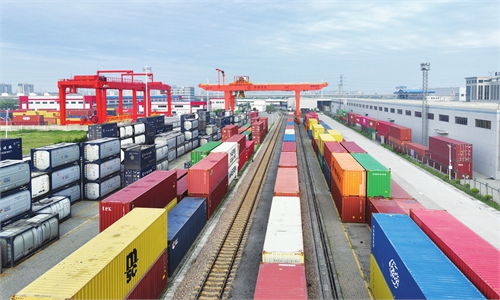
Illustration: Liu Rui/GT
In the past week, I was in Laos to attend a forum on the China-proposed Belt and Road Initiative (BRI). At the meeting, I learned that cluster bombs that the US military dropped in Laos 50 years ago turned out to be the biggest challenge to the construction of the China-Laos high-speed railway.However, when riding on the train and soaking in the beauty of the scenery, you may not realize that there used to be so many unexploded bombs buried along the route, most of which were cluster bombs dropped by US warplanes decades ago.
Coincidentally, on July 6 when I visited the UXO (unexploded ordnance) center in Luang Prabang, I learned that Washington's latest military aid to Ukraine will include cluster bombs.
Cluster bombs, also known as sub-bombs, send out hundreds or even thousands of tennis ball-sized sub-bombs when they explode, inflicting even more casualties.
Although the use of such bombs has been strongly condemned by the international community, the US has used them in almost all the wars it has waged since the Korean War (1950-53). Even though the US military claims that the technology for cluster bombs has improved dramatically, there is still a certain collateral damage rate.
Even today, decades later, cluster bombs that the US military dropped in the Laos still threaten the lives of the Lao people.
It is estimated that between 1964 and 1973, the US military dropped more than 2 million tons of bombs and 270 million cluster munitions on Laos, of which about 30 percent remain unexploded and about 80 million bomb-lets are scattered and hidden on the Lao soil. This makes Laos one of the most heavily bombed countries in the history of the world.
There is an UXO center in almost every major city in Laos that specializes in the disposal and management of UXO, helping locals understand the dangers of unexploded bombs, providing information and offering assistance to victims.
There you will see the true nature of cluster bombs and get up-to-date information on casualties caused by unexploded bombs that occur from time to time throughout Laos.
The information center is decorated with gruesome photos of casualties, a tearful indictment of the evils of the US forces that dropped the cluster bombs.
The statistics are even more appalling. According to the UN Development Program, more than 50,000 people have been killed or injured by UXO in Laos from 1964 to the present day; and more than 20,000 villages, or about one-third of the total number of villages in the country, continue to be under the threat of UXO.
The Lao people are the most vocal as the world's most significant victims of cluster munitions. The Lao Ministry of Foreign Affairs issued a statement on Monday calling on relevant countries or actors to stop using, transferring, or producing such munitions so that no more civilians in the world would be victimized by such weapons.
This year marks the 50th anniversary since the last American bombs were dropped on Laos. For five decades, Americans have made major promises to help clear UXO, and former US president Barack Obama promised $90 million in aid. But today Laos is still suffering, and lack of funding is one of the main problems in removing UXO, with 90 percent of the detection equipment in need of repair.
During the construction of the China-Laos railway from January 2017 to July 2019, some 459 pieces of UXO were cleared from 2,931 hectares of local land, as well as more than 460 pieces of related debris, according to a report by the UN Department of Economic and Social Affairs. Data from the Chinese side showed that more than $100 million was spent on UXO detection and clearance along the route to ensure the railroad's safety. The Lao side also sent special engineering units.
When the construction of the China-Laos railroad began, the Western media kept spreading rumors that the railroad was a "trap" dug by the Chinese for the Laotians. So let these rumor-mongers come to Laos to see how the Chinese dig "traps."
Tom Fowdy, a British analyst of politics and international relations, wrote that the Western media is sending a strange message: "The country that bombed you is your friend, while the one that built you a new railway is your enemy."
With the advancement of the BRI, China injects vitality into the peaceful development of Asia and the world. On the other side of the Pacific Ocean, the country that claims to be the world's supremacy is busy sending cluster bombs to Europe. How can Washington have the nerve to label itself as the "guardian" of world peace?
The author is a senior editor with People's Daily, and currently a senior fellow with the Chongyang Institute for Financial Studies at Renmin University of China. dinggang@globaltimes.com.cn. Follow him on Twitter @dinggangchina


